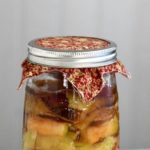Scrap Apple Cider Vinegar
Apple cider vinegar made from scraps is delicious and full of probiotics. It’s a great way to use up apple cores and peels. Perfect when making apple sauce or apple pie!
- Prep Time: 15 minutes
- Total Time: 15 minutes
- Yield: 1 quart jar 1x
- Category: Condiment
- Method: Fermented
- Diet: Vegan
Ingredients
Units
Scale
- Apple scraps (peels and cores; bruises are OK but no rotten bits)
- 1 cup water (chlorine-free)
- 1 Tbsp sugar per cup of water
- 1 Tbsp of apple cider vinegar with a mother per cup of water
Instructions
- This recipe is designed so you pack jars with apple scraps, then add as much water and sugar as you need to cover them. Adjust the measurements to suit the amount of apple scraps you have.
- Wash your apples before peeling them, then fill a glass jar 3/4 full of apple scraps. Just make sure the scraps are free of mold and bad spots.
- Mix the sugar, water and culture 1 cup at a time, then pour it over the apple scraps. Keep adding more cups of water, sugar and mother until you have just covered the apple scraps.
- The apple scraps will float, and that’s just fine. Cover the jar with a piece of cloth or a coffee filter and keep in place with an elastic band or jar ring. Do not use a sealed jar as it needs oxygen to properly ferment.
- Place the jar somewhere dark to ferment at room temperature. A closet is perfect.
- Check it every 2 to 3 days to stir.
- After 2 weeks strain out the scraps leave it to continue fermenting in jar covered with a piece of cloth for another month before bottling it. I usually let my vinegar age for at least 6 months. It will continue to age and darken and the flavor will improve.
Notes
- The vinegar may grow a thick rubbery pellicle, and/or there might be dark floating bits. Both of these things are fine. Mold is not OK… If you get mold then throw it out and start again. See the section above for more details.
- The vinegar will continue to ferment until all of the sugar is gone. So if it doesn’t taste sour after a month of fermenting, feel free to leave it for another 2 or 3 months.
